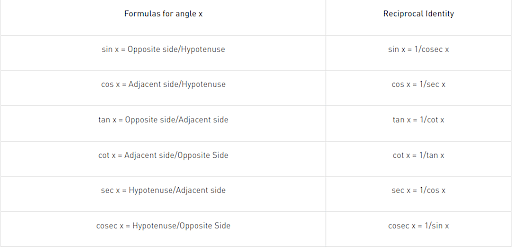$\Bigg(1+cos\frac{\pi}{8}\Bigg)\Bigg(1+cos\frac{3\pi}{8}\Bigg)\Bigg(1+cos\frac{5\pi}{8}\Bigg)\Bigg(1+cos\frac{7\pi}{8}\Bigg)$ is equal to
- $\frac{1}{2}$
- $cos\frac{\pi}{8}$
- $\frac{1}{8}$
- $\frac{1+\sqrt{2}}{2\sqrt{2}}$
The Correct Option is C
Solution and Explanation
$=\Bigg(1+cos\frac{\pi}{8}\Bigg)\Bigg(1+cos\frac{3\pi}{8}\Bigg)\Bigg(1-cos\frac{3\pi}{8}\Bigg)\Bigg(1-cos\frac{\pi}{8}\Bigg)$
$=\Bigg(1-cos^2\frac{\pi}{8}\Bigg)\Bigg(1-cos^2\frac{3\pi}{8}\Bigg)$
$=\frac{1}{4}\Bigg(2-1-cos\frac{\pi}{4}\Bigg)\Bigg(2-1-cos3\frac{3\pi}{4}\Bigg)$
$=\frac{1}{4}\Bigg(1-cos\frac{\pi}{4}\Bigg)\Bigg(1-cos3\frac{3\pi}{4}\Bigg)$
$=\frac{1}{4}\Bigg(1-\frac{1}{\sqrt{2}}\Bigg)\Bigg(1+\frac{1}{\sqrt{2}}\Bigg)=\frac{1}{4}\Bigg(1-\frac{1}{2}\Bigg)=\frac{1}{8}$
Top Questions on Trigonometric Functions
- Solve for \( x \), \[ 2 \tan^{-1} x + \sin^{-1} \left( \frac{2x}{1 + x^2} \right) = 4\sqrt{3} \]
- CBSE CLASS XII - 2025
- Mathematics
- Trigonometric Functions
- Evaluate: $ \tan^{-1} \left[ 2 \sin \left( 2 \cos^{-1} \frac{\sqrt{3}}{2} \right) \right]$
- CBSE CLASS XII - 2025
- Mathematics
- Trigonometric Functions
- The graph of a trigonometric function is as shown. Which of the following will represent the graph of its inverse?

- CBSE CLASS XII - 2025
- Mathematics
- Trigonometric Functions
- The integral \[ \int_0^\pi \frac{8x}{4\cos^2 x + \sin^2 x} \, dx \text{ is equal to:} \]
- JEE Main - 2025
- Mathematics
- Trigonometric Functions
- The value of \( \cos \left( \sin^{-1} \left(-\frac{3}{5}\right) + \sin^{-1} \left(\frac{5}{13}\right) + \sin^{-1} \left(-\frac{33}{65}\right) \right) \) is:
- JEE Main - 2025
- Mathematics
- Trigonometric Functions
Questions Asked in JEE Advanced exam
As shown in the figures, a uniform rod $ OO' $ of length $ l $ is hinged at the point $ O $ and held in place vertically between two walls using two massless springs of the same spring constant. The springs are connected at the midpoint and at the top-end $ (O') $ of the rod, as shown in Fig. 1, and the rod is made to oscillate by a small angular displacement. The frequency of oscillation of the rod is $ f_1 $. On the other hand, if both the springs are connected at the midpoint of the rod, as shown in Fig. 2, and the rod is made to oscillate by a small angular displacement, then the frequency of oscillation is $ f_2 $. Ignoring gravity and assuming motion only in the plane of the diagram, the value of $\frac{f_1}{f_2}$ is:

- JEE Advanced - 2025
- Waves and Oscillations
The reaction sequence given below is carried out with 16 moles of X. The yield of the major product in each step is given below the product in parentheses. The amount (in grams) of S produced is ____.

Use: Atomic mass (in amu): H = 1, C = 12, O = 16, Br = 80- JEE Advanced - 2025
- Organic Chemistry
Let $ a_0, a_1, ..., a_{23} $ be real numbers such that $$ \left(1 + \frac{2}{5}x \right)^{23} = \sum_{i=0}^{23} a_i x^i $$ for every real number $ x $. Let $ a_r $ be the largest among the numbers $ a_j $ for $ 0 \leq j \leq 23 $. Then the value of $ r $ is ________.
- JEE Advanced - 2025
- binomial expansion formula
- The total number of real solutions of the equation $$ \theta = \tan^{-1}(2 \tan \theta) - \frac{1}{2} \sin^{-1} \left( \frac{6 \tan \theta}{9 + \tan^2 \theta} \right) $$ is
(Here, the inverse trigonometric functions $ \sin^{-1} x $ and $ \tan^{-1} x $ assume values in $[-\frac{\pi}{2}, \frac{\pi}{2}]$ and $(-\frac{\pi}{2}, \frac{\pi}{2})$, respectively.)- JEE Advanced - 2025
- Inverse Trigonometric Functions
Let $ \mathbb{R} $ denote the set of all real numbers. Then the area of the region $$ \left\{ (x, y) \in \mathbb{R} \times \mathbb{R} : x > 0, y > \frac{1}{x},\ 5x - 4y - 1 > 0,\ 4x + 4y - 17 < 0 \right\} $$ is
- JEE Advanced - 2025
- Coordinate Geometry
Concepts Used:
Trigonometric Functions
The relationship between the sides and angles of a right-angle triangle is described by trigonometry functions, sometimes known as circular functions. These trigonometric functions derive the relationship between the angles and sides of a triangle. In trigonometry, there are three primary functions of sine (sin), cosine (cos), tangent (tan). The other three main functions can be derived from the primary functions as cotangent (cot), secant (sec), and cosecant (cosec).
Six Basic Trigonometric Functions:
- Sine Function: The ratio between the length of the opposite side of the triangle to the length of the hypotenuse of the triangle.
sin x = a/h
- Cosine Function: The ratio between the length of the adjacent side of the triangle to the length of the hypotenuse of the triangle.
cos x = b/h
- Tangent Function: The ratio between the length of the opposite side of the triangle to the adjacent side length.
tan x = a/b
Tan x can also be represented as sin x/cos x
- Secant Function: The reciprocal of the cosine function.
sec x = 1/cosx = h/b
- Cosecant Function: The reciprocal of the sine function.
cosec x = 1/sinx = h/a
- Cotangent Function: The reciprocal of the tangent function.
cot x = 1/tan x = b/a
Formulas of Trigonometric Functions:
